Our hotel manager in Bruges couldn't have been more charming and welcoming when we arrived in the capital of Belgium's Flemish area.
We heaved a sigh of relief when we found that our mini-apartment was half of the home out back rather than having to climb several flights of steep stairs. That was at least until we found that our staircase was so steep and curvy we left our bags by the entrance!
Our suitcases fit just perfectly by the door as long as we didn't want to open the door all the way!
The tiny nook under the stairs had just enough space for a fridge and kettle and to make a cold sandwich for dinner.
It was quite challenging to make it up or down the steep, open stairs in the middle of the night when nature called or I went to bed later than my Sherpa! I was always concerned I'd miss a step and go a-tumbling down as there was no railing on one side.
Open stairs are definitely not my favorite design and even less so now after negotiating my way up and down them for five days!
There was at best eight to ten feet between the door to the apartment and the bathroom door or just inches from the chair - just glad we love each other so much! The apartment really did work out well, probably because we were gone every day all day as otherwise, the tight space would have been challenging.
After dumping our stuff, we began exploring the city.
Our hotel in Bruges could hardly have been in a more convenient location with just a 15-minute stroll to the heart of the city through the most picturesque and peaceful lanes. It was such a pleasant change not being surrounded by bars whose patrons liked to keep far later hours than we did!
After just having visited both Brussels and Antwerp, the Markt or Market Square began looking quite familiar with great old gabled buildings, golden statues atop them, and a statue in the middle of the square! The square was adorned with flags depicting the country’s, the state's as Bruges is the capital of the Flanders region, and the European Union flag.
Back in the 1300s before the lay of the land changed, Bruges was a major seaport and a canal came right up to Markt and boats moored right here.
During the Middle Ages, farmers from the area then used to ship their cotton, flax, wool, and hemp to the Bruges port where hardworking locals would spin, weave and dye it into a finished product that would then be loaded onto boats and shipped around the known world. By 1400, Bruggians traded tapestries, furniture, and cotton-rag paper that replaced parchment and was made here in Flanders. One of the Continent’s finest bookmakers worked here in Bruges.
Bruges’ oldest house was here on the square - the 15th-century rectangular-shaped house with the modern golden ball on top.
Though Café-Brasserie Craenenburg has been on the square since the 15th century, most of the others had been rebuilt in the 19th century in an exaggerated medieval style called Neo-Gothic with “lacy stonework, fanciful towers, leering gargoyles, and spiky spires."
The statue in the middle of the square showed two friends, Jan Breidel and Pieter de Coninc who assisted in putting Bruges on the world map in 1302. They led the citizens of Bruges against their French oppressors in the Battle of the Golden Spurs, the medieval world’s first victory of foot soldiers over the cavalry, of common people over nobility.
Dominating the Markt since 1300 was the massive Bell Tower with the octagonal lantern added in 1486 which made it 290 feet tall.
The courtyard was a mecca for tourist groups led by flag-holding guides keeping their charges in line! We’d return to the courtyard in several days to hear one of the carillon concerts played on the 47 bells using a keyboard and foot pedal like an organist. I hadn’t known how physically tough an instrument it is as musicians must use fists and feet rather than fingers!
We could have climbed the tower and likely a few years ago would have but ascending its 366 steps didn’t seem even worth the chance to view the towns on the North Sea coast.
At the base of the tower was a popular Belgian 'frites' stand as its people sure love their fries. We tried them in two different cities and didn't think they were worth writing home about even though two tastes were hardly a fair number to judge.
Strolling along Geldmunstraat with its exquisite lace and tapestry shops that Belgium is so famous for was a delight.
A chance to eat a Smarties-and-chocolate-dipped hot waffle on a stick on the straat or street couldn’t be passed up! Perhaps I should have made the climb to the bell tower after all before rewarding myself! As we’d generally been averaging close to ten miles a day, I didn’t feel like I couldn’t indulge in the occasional croissant or even chocolate confection like this one, however. Smarties, by the way, are Canada’s (and the UK’s, Phil and Michaela!) answer to M&Ms.
Inner Circle was an art installation by Nadia Kaabi-Linke that comprised a bench covered in sharp, shiny pins which made it impossible to sit down on. The idea was that it was based on signs on buildings listing exclusive clubs or associations and that the line between hospitality and exclusion is often fragile in elite groups.
On a much lighter note was this fellow!
The street led to the opulent Burg Square which had been Bruges’ historical birthplace, political center, and religious heart for a thousand years. As pleasant as Markt had been, Burg Square pulled out all the stops for us with the fancy Romanesque gray-and gold Basilica of the Holy Blood in the corner,
the pointed Gothic arches and prickly spires of City Hall, a
symbol of the city’s proud independence,
the well-proportioned windows of Renaissance Hall next door,
and the elaborate 17th-century Baroque Provost House to the left of the Renaissance Hall.
The Courtyard of the Provost House:
Looking closer at City Hall, its façade of 49 statues showcased key figures in Bruges’ history.
Though it was a little like trying to find a needle in a haystack, eagle-eyed Steven did succeed in locating Baldwin I who founded Bruges in the 9th century when he built a fort here.
Thiery of Alsace in the upper right tower was shown grabbing his sword hoping to secure the holy relic that would put Bruges on the all-important pilgrimage map.
The Basilica of the Holy Blood was built circa 1150 by a brave Crusader to hold the drops of blood he’d brought back from Jerusalem.
We first visited the Upper Chapel whose original Romanesque décor had been gutted by secular humanist French revolutionaries in 1799 and then replaced by this splendid Neo-Gothic 19th-century style. The nave was colorful with its painted walls and curved wood ceiling,
an unusual round pulpit carved from a single massive oak,
and stained-glass windows of the dukes who governed Flanders with their duchesses.
Our eyes had immediately been drawn to the large painting behind the altar that told the story of how the Holy Blood reached Bruges.
Thiery of Flanders, whose statue we’d just picked out on the City Hall façade, was also the Count of Flanders. He was painted kneeling before the thankful Christian patriarch of Jerusalem after helping to defend Bethlehem and Jerusalem from Muslim insurgents. Thiery was then rewarded with the relic.
In another scene just visible between the scaffolding, Thiery was depicted back home kneeling before the bishop of Bruges, giving him the vial of blood.
In a tabernacle in the adjoining nave beyond the three arches was normally kept the relic itself that had been preserved in a clear tube of rock crystal.
The tabernacle:
We were fortunate that the relic was displayed that day on the throne under the canopy so I had the chance to view it up close. I can’t admit to ‘feeling’ any miraculous powers or presence, however. On most days, the relic was placed in the tall, silver tabernacle on the altar and, only on Fridays are its doors opened. It was only on holy days that the relic is ‘supposed’ to be on the throne as it was when we visited.
When I paid my respects and made a donation at the relic, the deacon (?) kindly gave me this card with prayers on it.
Steven waited in the church while I visited the adjoining Treasury to view the impressive gold and silver, gem-studded hexagonal reliquary. It dated from 1600 and is used to parade the relic around on feast days. The ‘casket’ at the bottom of the three-foot-tall structure holds the vial.
A video in the Treasury showed the relic being transported through Bruges streets.
On either side of the shrine were paintings of the Brotherhood of the Holy Blood, the 31-member fraternity that had tended the shrine and organized the pageantry for centuries and is still active today. What a sight it would be to see members of the Brotherhood hold the reliquary on their shoulders as they parade through the streets on special occasions!
Also in the chamber were other ceremonial objects belonging to the Brotherhood including a centuries-old hunting horn that sounds the alarm on the anniversary of the murder of a Flemish nobleman that happened close by in 1127.
The fine tapestry was also a reminder of Bruges’ glory days as a textile manufacturer. As this was the third city we were touring in Belgium, I was extremely disappointed that none of the cities had any collection of Flemish tapestries in any museum unless there may be some in the Royal Museum of Fine Arts in Brussels that was closed. Steven and I have been extremely lucky to view magnificent Flemish tapestries in other countries but I had thought we'd see many more in their homeland.
The reliquary had belonged to Albrecht and Isabella in 1611.
Maria of Burgundy's 15th-century crown:
The small lead box holding the broken glass tube was a replica of the precious rock-crystal vial holding Christ’s blood. The box had protected the vial from Protestant extremists in 1578 and French revolutionaries in 1799 who were hell-bent on destroying what was to them a glaring symbol of Catholic hocus pocus
The stark and dim décor of the Basilica’s Lower Chapel was in sharp contrast to the bright and cheery chapel upstairs. We were reminded of the medieval piety that inspired crusading Christian Europeans to try and liberate the Holy Land from Muslim rule. The style was pure Romanesque with rounded arches and heavy pillars.
The painted wooden Virgin and Child dated from 1300.
In the annex were somber statues of Christ being tortured and a relief panel over the doorway showing 4th-century scholar and monk St. Basil being baptized by a priest.
I felt a greater sense of 'peace and serenity' both in the glorious Upper Chapel itself and the simple Lower Chapel than I did looking at the holy relic for some reason.
Back on beautiful Burg Square again, we found the narrow passageway between Renaissance Hall and City Hall called Blinde-Ezelstraat. The alley was called Blind Donkey Street because donkeys in medieval times carried fish on their backs from the North Sea and their owners put blinders on them so they would cross the canal between the old city and the fish market!
At the entrance to the alley was a Virgin Mary statue the locals lovingly refer to as the Lady of the Inkpot as they would nod to her as they walked past. She is still the protector of the city council.
Midway along the alley was an original iron hinge from the city's south gate when the city had been circled by a moat and shut down at 10 pm.
I'm glad we waited so long to come to Belgium as this is what the walls looked like before the grime was removed in the 1960s - ooh, yuck!
The alley opened up to a pretty canal that had been the 13th-century moat around the old city. Bruges or Brugge as the city was known here in the Flemish area of Belgium was named for the Flemish word for 'bridge' as there were so many over the canals as you'll soon see!
I always think of Steven when we come across odd-looking gargoyles as he is fond of searching them out.
With the North Sea just 12 miles away, fresh fish used to be sold daily at this Vismarkt or ... surprise, surprise the Fish Market. Now, the most regular 'catch' are the tourists who stop to look at the arts and crafts!
Tiny Huidevettersplein was a picturesque square filled with cafes and restaurants that used to be the headquarters for Bruges' skinners and tanners. The lions atop the square's column held the tanners' logo, an industry that was once very important to the city.
To more clearly see the relief panels of scenes from the leather trade on the hotel facade on the column's left, just click on the photo to make it bigger as you can with any photo in any post.
A few steps away was another of the pretty as a postcard views of the quaint canal lined with old gabled-roof homes. If I could leave you with just one shot that would be the heart and soul of Bruges, it might be this one that explains why Bruges has been called Venice of the North. Steven and I will soon be in Italy for five weeks but won't be visiting the 'real' Venice in all that time. Guess little Venice will have to do!
Did you notice how the Bell Tower we'd seen in Markt earlier was tilting? Fortunately, it hadn't leaned anymore than four feet since it was first detected in 1740.
As Bruges was the final destination of an international professional bike race that day, there were bike-themed references all over town.
Another delightful bridge over a tiny canal in a city that was full of them! In the background was the Church of Our Lady.
Crossing the bridge brought us to a small garden with a bust of Juan Luis Vives, 1492-1540, whose writings on the connection between the body and the soul made many consider him the 'father of psychology.'
A shot of the bridge from the square:
For some reason, in all our time in Bruges Steven and I never talked about taking a boat tour along the canals although we kept seeing oodles and oodles of tour boats on the canal. If you ever get to Bruges, I hope you'll let me know how much fun a boat tour was.
The tiny lane was Stoofstraat or Stove Street where the neighborhood bathhouse was located. It would have also served as a place to hang out and socialize in addition to bathing.
Another few steps took us to yet another charming square, Walplein, that was again filled with patrons enjoying hot and cold beverages at sidewalk cafes. It didn't look like the pandemic was causing a downturn in business for the owners thankfully.
If I didn't already have enough small bags and little enough time at home to use them, I would have bought a couple of these tapestry purses that were very reasonably priced and made here in Belgium. I liked them so much because you would presumably see few women using them back in the States.
As Steven's not a beer connoisseur and I'm not a beer drinker at all, we did no more than look at the De Halve Maan Brewery even though Belgium is well renowned among beer lovers.
In addition to boat tours, visitors to Bruges could take romantic carriage rides through the city. Horses could stop at the horse head fountain for a soothing drink.
As it had been a fairly long day already since leaving Antwerp that morning, our last stop was entering Begijnhof, an enclave built in the Middle Ages to house religious but lay women of the Beguines who weren't required to take the vows of a nun but did need to obey a mother superior. Access was across a bridge and through a gate that said Sauve Garde as we were entering the protection of the sisters and no longer under the city's jurisdiction. The relief on the gate pictured St. Elizabeth taking care of the handicapped.
UNESCO had recognized in 1998 the Ten Wijngaerde beguinage and 12 other Flemish beguinages because of their "unique testimony to the medieval mystical movement which produced them." The beguinages comprised women who wished to live and independent but committed lives outside recognized orders but with vows of fidelity and poverty. When we were in Amsterdam a few years ago, we visited our first begijnhof and that was why we wanted to see the one in Bruges.
The beguinages were organized into self-supported 'cities of peace' with central courtyards surrounded by harmonious brick buildings. Visitors were welcomed but asked to preserve "the peaceful character of this close by keeping a worthy and reflected attitude."
Dominating the courtyard was the church with its oh-so peaceful interior, corkscrew columns, and tombstones on the floor.
On the right wall was an 800-year-old statue of Mary.
To announce a sung vespers service, a nun pulls the rope dangling from the ceiling!
I could easily see why women would be drawn to such a place of refuge and quietude. It was the perfect, restful end to our initial tour of Bruges.
This was one of the many English-language signs I spotted in Bruges. Certainly, unilingual English speakers have nothing to fear in Belgium!
Next post: Visting Church of Our Lady and Sint-Janshospitaal, an almshouse and more of delightful Bruges.
Posted on October 1st, 2021, from Zurich, Switzerland that we reached just yesterday afternoon after a couple of days unexpectedly visiting the Black Forest area of Germany.

































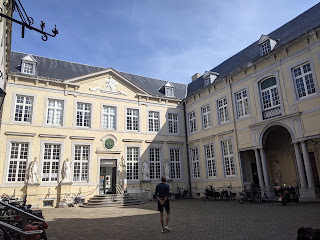


























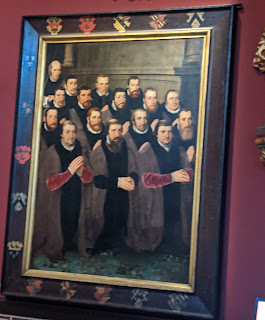
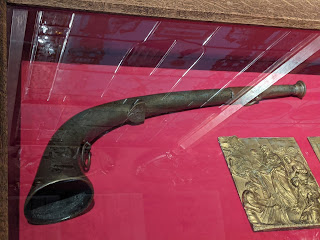














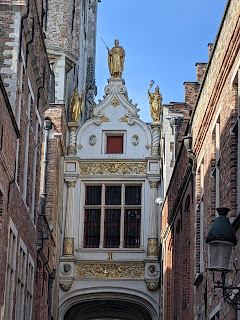









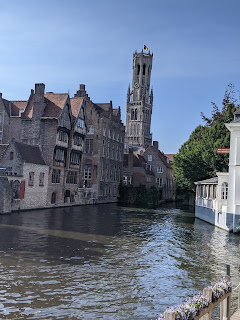



























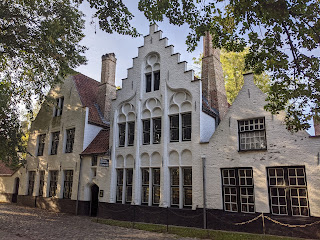












Beautiful Bruges indeed ... precarious staircase, decadent smartie-garnished waffles, magnificent lace, endless canals, peaceful lanes, beautiful basilica .. thanks for sharing your wonderful day with us. xoxo
ReplyDeleteI hope you and Dan travel to Bruges someday AND take a canal tour, Lina. I know you'd love the city as much as we did.
DeleteXOXO right back at you,
Annie
Glad that you two are enjoying your travels! Thank you for sharing them with us.
ReplyDeleteBlessings,
Karen & Mike
Thanks for reading the post as you both get ready for your European travels soon, Karen.
DeleteAll the best, Annie